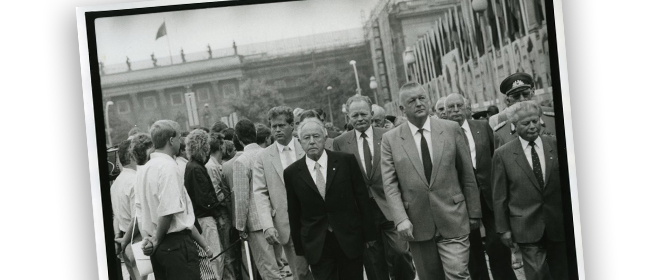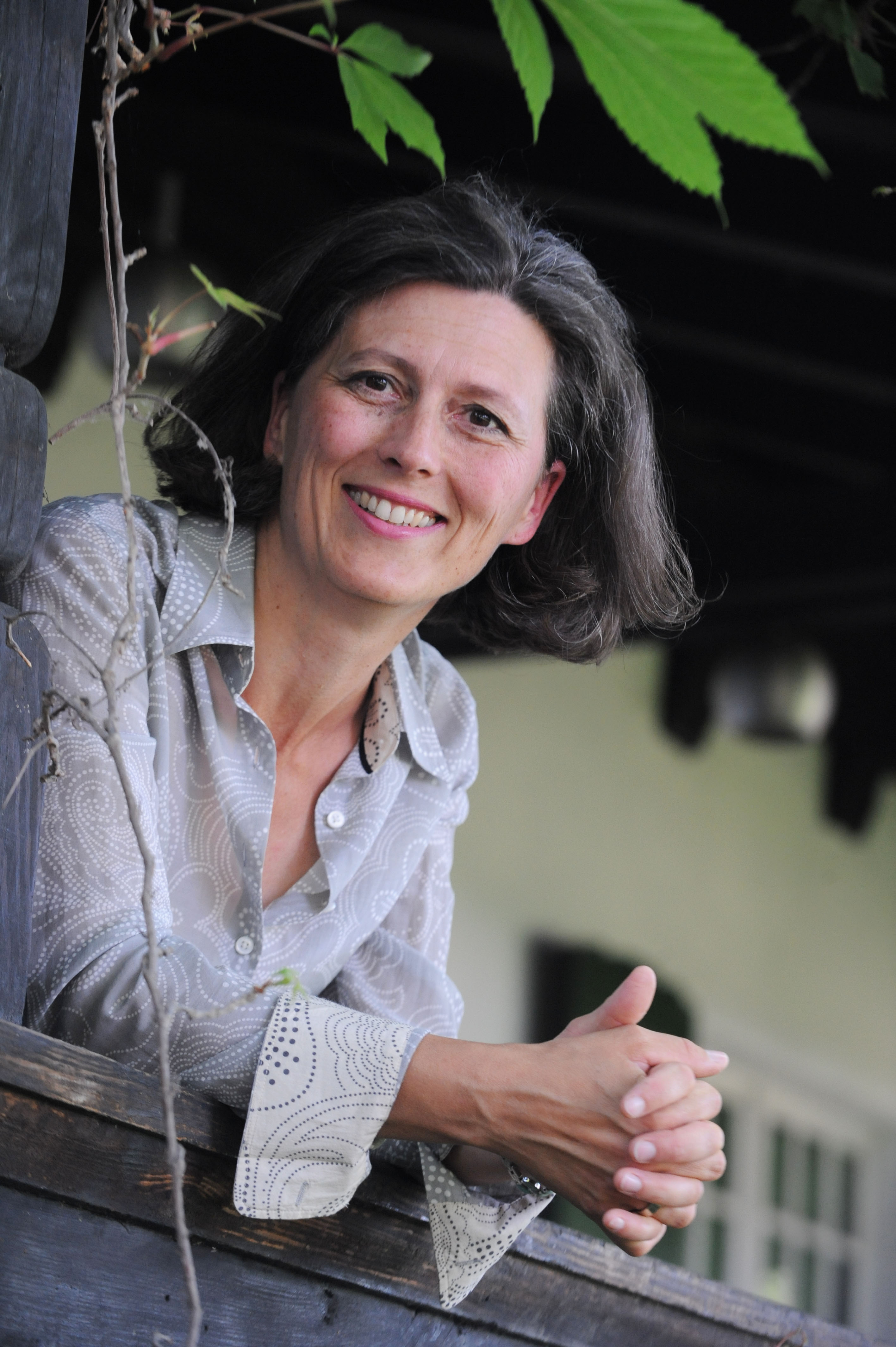
“We are not curious, we are simply inquisitive”
Special Occurrences – 30 years ago today | Part 2
Zsuzsa Breier | 17 April 2019
The year 1989 develops into the most important turning point in post-war Europe. As an exclusive preprint from her book, the literary scholar and diplomat Zsuzsa Breier provides us in four contributions for the DHM blog with insight into the dynamic developments in Germany and Hungary thirty years ago.
On March 1, 1989, seventy Hungarian conscientious objectors to military service were released from prison, after the introduction of a new law allowing for alternative civilian service in lieu of conscription.
On the same day, ten members of the Committee for Historical Justice (TIB) met in Budapest. Almost exactly a year previously, the committee’s thirty-two founding members had issued the Appeal to Hungarian Society:
For three decades, wild bushes have grown over plot 301 of Rákoskeresztúr cemetery, concealing hundreds of victims of the vengeful neo-Stalinist purges of November 4, 1956. Even today, relatives of the victims have not been told which ditch or which spot of the bleak prison graveyard contains their loved ones…
We are appealing to Hungarian society to join us in demanding an honourable burial for those executed and in building a national memorial to keep alive the memory of Stalinist despotism and of the liberation struggle fought against it, and to commemorate the victims. 1
The meeting’s agenda included the points Test Exhumations and Funeral, but at this point in time the participants had no idea of the impact of these words, or that the Funeral would soon make history.
Developments in Hungary had raised concerns at the Ministry of State Security in Berlin (the MfS, otherwise known as the Stasi). On March 2, Lieutenant Weller, head of the MfS’s Operative Group in the Hungarian People’s Republic, reported to Berlin:
Comrade (Lieutenant Colonel) Kivago, Marika gave me… some hints… There was genuine fear at the demands of the so-called alternative groups, in particular the newly re-formed Social Democratic Party of Hungary.
The aims and ideas of this party were announced at a meeting in Budapest on March 1, 1989: the dissolution of the military blocs – Hungarian sovereignty and neutrality – radical reform of property relations – refusal of autocratic rule of any organization or social class – professional soldiers and officers, along with lawyers and judges, should not belong to any political party – parties should not form associated armed groups – …
… (Kivago) was concerned, and spoke of his fear that only those not affiliated to the Party would be allowed to continue working for the security forces, and felt completely at a loss at this prospect… However, in the course of the conversation, a possible inclination on the part of some security service personnel became apparent, namely that if push came to shove, they would give up Party membership and in this way stay with the Ministry. 2
Erich Mielke, the head of the Stasi, always put great store on relationships with East Germany’s ‘brother nations’ in Eastern Europe. At an informal meeting in 1979, he said to the head of the delegation from the Hungarian secret service:
We are not curious, we are simply inquisitive, because we must draw conclusions for ourselves and our own security, and because we must identify any effects these phenomena may have on the GDR. 3
In 1988, one of his conclusions went as follows:
We are faced with a new situation. Cooperation with agencies of allied countries is not becoming any easier. We can see this in developments of recent years, for example, political circumstances are changing in ways that put them out of step with our own. 4
East Germany had recently introduced new rules for citizens’ travel overseas, but these were of little use when too much underwear, a passport photograph, or a photograph album brought disaster on travellers confronted by suspicious officials:
Lutz M. (20), boat builder … not a party member, no previous convictions, married since February 11 1989…
Marion (20), waitress, unemployed since 27 February 1989.
Political-operative analysis of the ‘Honeymoon’ case resulted in the suspicion that the couple M. intended to use their planned honeymoon in Warsaw, from March 1 to March 4, 1989, to leave the GDR without intention to return….
After it was further established that the couple M. had booked a flight from Berlin-Schönefeld to Warsaw for March 1, 1989 at 10:30 a.m., an intensive customs examination was arranged. The examination resulted in the discovery of further items of documentation … Colour passport-sized photographs of both Thomas M. and Marion M… A pers. photograph album with pers. photographs (of the keepsake variety)… A copy of the ‘Neue Zeit’ newspaper from December 14, 1988 which includes the publication of the ‘Ordinance on Travel Abroad by GDR Citizens’….
In addition, the suspects’ luggage contained an amount of underclothing disproportionate to the duration of their intended journey. On the basis of this evidence, both were removed from the Warsaw flight and at around 12:15 p.m. were taken as suspects for examination to KD Köpenick of EG IX of the PdVP Berlin….
It is advised that Thomas M. and Marion M. be prosecuted on grounds of preparing not to re-enter the GDR, as per §213 (2) (3) 4, 5 (4) of the legal code, with a view to eventual imprisonment. 5
On March 1, the West German medical magazine Ärzteblatt reported on aid to Hungary organized by Baroness Csilla von Boeselager, accompanied by a picture of the baroness in her wood-panelled study in the moated castle of Höllinghofen:
The fireside lounge in Höllinghofen Castle, in the idyllic setting of Arnsberger Forest, has become ‘Operation Headquarters’ for an unprecedented undertaking…
… in the last fourteen months the Baroness has managed to send thirty-five truckloads of aid to Hungary, worth some 6.5 million deutschmarks, donated by West German hospitals and medical practices. Since January 1, 1989 another twelve shipments have been sent across the border. Donations have reached an overall total of 220 million forints. This compares with the Hungarian Ministry of Health and Social Welfare’s total investment budget of 635 million forints for this year… 6
Meanwhile, hardliners in the Hungarian Socialist Workers’ Party (MSzMP) were considering declaring a state of emergency. At the end 0f 1988, Károly Grósz, the general secretary, announced the formation of a commission comprising ten likeminded senior Party officials. In public, he denied that this was to be an emergency committee, but it included Sándor Borbély, commander of the much-feared Munkásörség, a paramilitary workers’ militia, while excluding reform-minded leaders like Imre Pozsgay and Miklós Németh. On this question, the Party boss would later observe:
… since the beginning of 1989, I could no longer trust the chosen leadership of the Party… Miklós Németh resented our decision not to include him in working out our plans…, to which I said that if he were to be invited to join the Commission then I might as well invite Mr. Palmer, the US ambassador, to participate as well … because no matter what was discussed in the Politbüro, Palmer would know all about it by the following morning….
Indeed, just a few years earlier the situation had been quite different. Back then Erich Honecker (of the GDR) and János Kádár (of Hungary) had still gone hunting with Soviet leader Leonid Breshnev. Now however, the reformist prime minister Németh was known to play a morning game of tennis with US ambassador Marc Palmer, rather than with the Soviet ambassador.
Other figures who once would have been regarded as enemies from the non-socialist abroad now suddenly appeared well-regarded in Hungary. These even included former Crown Prince Otto von Habsburg. In March 1989, after seventy-three years’ absence, he officially returned to Hungary for the first time. He had last made an official appearance in the city at the age of four, attending the coronation ceremony of his father Charles IV and his mother Zita in the Matthias Church in Budapest in 1916. At the age of seventy-seven, he now made an official return to the former Habsburg crownland as part of a delegation from the European Parliament. Only a couple of years before, Hungary had maintained a ban on any member of the Habsburg family: in 1946, a government decree confirmed that the issuing of Hungarian passports for any member of the Habsburg family is not permitted, 7 but on July 15, 1987, Hungary’s foreign minister Péter Várkonyi had declared that he had no objection to Habsburg family members entering the country, in view of the loyal attitude towards Hungary shown by the former heir to the throne. When Von Habsburg had made his first, strictly private visit to the country on August 1, 1987, Várkonyi even instructed border officials to allow his passage without obstacle. 8
One year later, the former crown prince made a second private visit to Hungary, during which he is reported to have stood moved before the crown on display in the National Museum. However, his official visit drew far more public attention:
He attracted considerable attention wherever he appeared, some people immediately received him with spontaneous joy, others with reservation. The latter group not only feared the return of the old epoch, but also that his visit would be grist to the mill of the opposing political camp. 9
The visit also created a stir abroad: in a highly confidential telegram to Budapest sent on March 3, 1989, Hungary’s ambassador to Denmark noted:
I consider it my duty to report that Gerhard Gmoser, the Austrian ambassador to Denmark… was quite put out by the enthusiastic reception of Otto Habsburg in Hungary, asking if we hadn’t got the proportions wrong between the attention afforded Otto Habsburg in relation to the rest of the delegation? 10
Hungary was left having to explain its position. The warm reception for the former Habsburg heir in a communist country above all alienated the social democrats in the delegation, and the reform-minded Hungarian Socialist Workers’ Party did not want to endanger its nascent contacts with European social democrats. For this reason, the Hungarian foreign ministry immediately issued the following statement:
The Hungarian government highly values the efforts of Otto Habsburg to develop relations between Hungary and the European Union, but this circumstance in no way indicates that we share the general political philosophy of the aforementioned person. 11
SOURCES
1 beszélö 25, 88/3 (all translations are by the author, if not otherwise specified).
2 BStU, MfS, X. 61, 34.
3 BStU, MfS, HA 9, 60.
4 BStU, MfS, HA VI 8, 7.
5 MfS ZOS 3584, 349.
6 Die Neue Ärztliche, no. 42, March 1, 1989.
7 MNL OL XXXII-J-13-2861-1946.
8 MNL OL XIX-J-1-j-1987.
9 MTI July 18, 1988, cited from mnl.gov.hu.
10 MNL OL-XIX-J-1-j-1989.
11 MNL OL XIX–J–1–j–1989–A–10–10–001442.
 © Uwe Steinert |
Dr. phil. Zsuzsa BreierBorn in Budapest in 1963. Studied literature and cultural studies at Eötvös Loránd University, taught modern German literature at her home university and cultural management at Berlin’s Humboldt University, joined the diplomatic service in 2004, organized the “Kulturjahr der Zehn“ [Cultural Year of the Ten], and founded the “Gesellschaft zur Förderung der Kultur im erweiterten Europa” [Society for the promotion of culture in extended Europe] and published the anthology “Freiheit, ach Freiheit…“ [Freedom, oh freedom …]. In 2012, she was appointed Secretary of State for European Affairs by the Hessian state government. In 2015, she headed the Handelsblatt Global Edition. Since 2016, she has been researching the year 1989. |